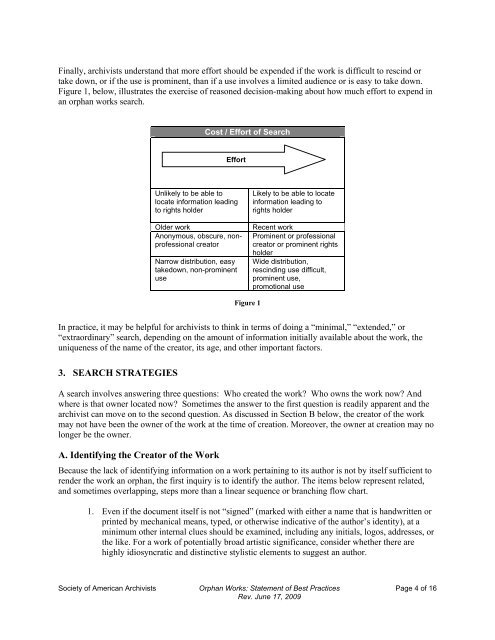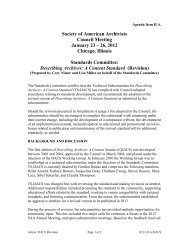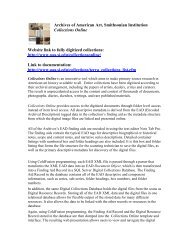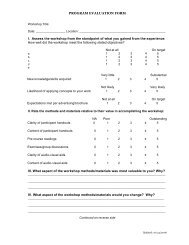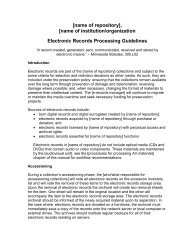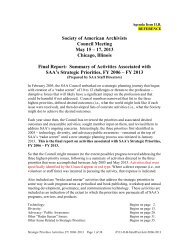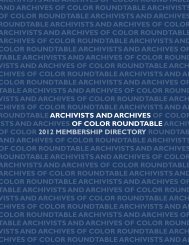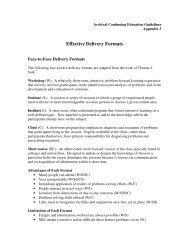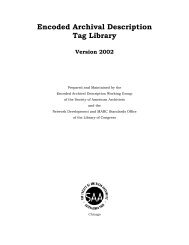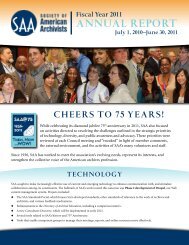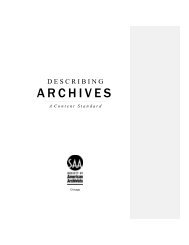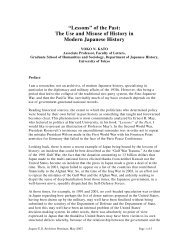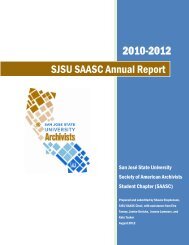Finally, archivists understand that more effort should be expended if the work is difficult to rescind ortake down, or if the use is prominent, than if a use involves a limited audience or is easy to take down.Figure 1, below, illustrates the exercise <strong>of</strong> reasoned decision-making about how much effort to expend inan orphan works search.Cost / Effort <strong>of</strong> SearchEffortUnlikely to be able tolocate information leadingto rights holderOlder workAnonymous, obscure, nonpr<strong>of</strong>essionalcreatorNarrow distribution, easytakedown, non-prominentuseLikely to be able to locateinformation leading torights holderRecent workProminent or pr<strong>of</strong>essionalcreator or prominent rightsholderWide distribution,rescinding use difficult,prominent use,promotional useFigure 1In practice, it may be helpful for archivists to think in terms <strong>of</strong> doing a “minimal,” “extended,” or“extraordinary” search, depending on the amount <strong>of</strong> information initially available about the work, theuniqueness <strong>of</strong> the name <strong>of</strong> the creator, its age, and other important factors.3. SEARCH STRATEGIESA search involves answering three questions: Who created the work? Who owns the work now? Andwhere is that owner located now? Sometimes the answer to the first question is readily apparent and thearchivist can move on to the second question. As discussed in Section B below, the creator <strong>of</strong> the workmay not have been the owner <strong>of</strong> the work at the time <strong>of</strong> creation. Moreover, the owner at creation may nolonger be the owner.A. Identifying the Creator <strong>of</strong> the WorkBecause the lack <strong>of</strong> identifying information on a work pertaining to its author is not by itself sufficient torender the work an orphan, the first inquiry is to identify the author. The items below represent related,and sometimes overlapping, steps more than a linear sequence or branching flow chart.1. Even if the document itself is not “signed” (marked with either a name that is handwritten orprinted by mechanical means, typed, or otherwise indicative <strong>of</strong> the author’s identity), at aminimum other internal clues should be examined, including any initials, logos, addresses, orthe like. For a work <strong>of</strong> potentially broad artistic significance, consider whether there arehighly idiosyncratic and distinctive stylistic elements to suggest an author.<strong>Society</strong> <strong>of</strong> <strong>American</strong> <strong>Archivists</strong> Orphan Works: Statement <strong>of</strong> Best Practices Page 4 <strong>of</strong> 16Rev. June 17, 2009
2. If the document itself is not marked, then the next step is to examine adjacent materials forcontextual clues. At a minimum, for example, examine all other documents in the same filefolder in which the potential orphan work is located to see if the content <strong>of</strong> other documentscontains clues. This might apply, for example, in a case in which there is an unsignedphotograph in a file <strong>of</strong> correspondence with a particular person and the photograph wasoriginally an enclosure in one <strong>of</strong> the letters. It might also apply where a single sheet <strong>of</strong> anunsigned letter is related to other letters to or from a person with the same handwriting orstationery. Note: In most instances, this examination for contextual clues may be limited tothe folder in which the work was found.3. Although it would not be reasonable to have to examine all <strong>of</strong> the other documents in thecollection in which the work is located, reasonable further contextual steps might include, at aminimum, a thorough examination <strong>of</strong> the finding aid for the collection to determine if similarworks have been filed elsewhere in the collection, and then examination <strong>of</strong> any folders thatappear appropriate. A related reasonable minimal step would be to examine the donor oraccession files for evidence <strong>of</strong> names <strong>of</strong> correspondents <strong>of</strong> the collection creator.4. If the previous three steps do not allow identification <strong>of</strong> any name for the author <strong>of</strong> the work,then it may be considered an anonymous work for which neither authorship nor rights holdercan be established, and thus reasonably treated as an orphan work unless other conditionsapply, such as internal evidence that it was a work <strong>of</strong> employment.5. Another minimum reasonable step in determining the identity <strong>of</strong> the author <strong>of</strong> a prospectiveorphan work should be to confer, if possible, with the archivist or manuscript curatorresponsible for the collection and to inquire about the existence <strong>of</strong> any relevantdonor/acquisition documentation.6. When a name can be located, an expanded search would include conferring with a referencelibrarian or genealogist to establish the author’s specific identity.7. If the previous six steps provide a reasonable indication <strong>of</strong> the author’s name, the nextreasonable step is to determine if the name is distinctive enough to establish identity. Forexample, a letter signed “Jane Smith” with no other contextual clues, such as place <strong>of</strong>residence, will present greater difficulties than one signed “Helga Winterbottom” on a letterposted from Helena, Montana, in 1962. If the name on the document is not sufficiently clearby itself, then the contextual investigations in steps 2 through 4 would be reasonable. In allcases, a carefully done search in Google or another robust search engine should be regardedas only a minimum step in determining actual identity <strong>of</strong> individuals with common names.B. Identifying the Rights HolderThe default starting position for any orphan works investigation must be the creator <strong>of</strong> the work becausethe working assumption is that the creator is the copyright owner. There are, however, at least threesituations, in which the initial author may not be the copyright owner:<strong>Society</strong> <strong>of</strong> <strong>American</strong> <strong>Archivists</strong> Orphan Works: Statement <strong>of</strong> Best Practices Page 5 <strong>of</strong> 16Rev. June 17, 2009


